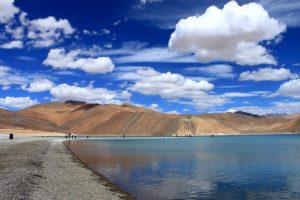The India-China crisis in eastern Ladakh shows no sign of abating three and half months after it started. On June 15, armies of the two countries clashed at a location there leading to the deaths of 21 Indian soldiers and an unknown number of Chinese troops — the worst incident of violence in more than half a century. Indian media report that talks between military commanders from both sides are deadlocked, with neither side willing to make concessions. On Monday, the Indian chief of defense staff, General Bipin Rawat, pointedly noted that the military option remains on the table should negotiations at the military and diplomatic level to resolve the dispute fail. At the same time, other recent media reports suggest that a massive buildup of the Chinese People’s Liberation Army (PLA) across the Line of Actual Control (LAC), a largely undefined boundary that separates Indian and Chinese territory.
Five rounds of talks so far between Indian Army and PLA commanders have failed to resolve the crisis that started early May, following China’s intrusions across what India considers the LAC along a wide frontage in eastern Ladakh. (The Diplomat’s Ankit Panda has a detailed backgrounder, with satellite-image analysis, on the crisis here.) Following the last round of talks, Indian official sources explained to the Hindustan Times: “Talks are stuck in a stalemate because of the India Army’s insistence that the PLA must withdraw to positions held by it as of April 2020, and the Chinese reluctance to restore status quo ante in some areas.”
Among them is the Pangong Lake area, where the PLA has constructed a road through a “grey zone” arising from overlapping claims about the LAC there. India and China have not exchanged official maps marking the LAC, making the entire dispute a case of pushing back each other’s perception of where the boundary lies.
The Print reported yesterday that besides the Pangong Lake area, the PLA has also refused to relinquish its new claims in Galwan Valley, Depsang Plains, and Gogra. Another Indian media outlet notes China’s significant military build-up — including additional radars and patrol posts — across several other sectors along the 3,488-kilometer LAC. On its part, India has forward deployed an additional three divisions worth of troops to eastern Ladakh along with commensurate additional weapons and platforms.
After official near-silence and even denial from the Indian side, the establishment in New Delhi is becoming increasingly vocal about China’s recent intransigence. On July 3, Prime Minister Narendra Modi visited a forward post there, flanked by Rawat and Indian Army Chief M. M. Naravane. Reacting to the development, Chinese Foreign Ministry spokesperson Zhao Lijian remarked, “No party should engage in any action that may escalate the situation at this point.”
Two weeks later, after a trip to review military preparedness in Ladakh, the Indian defense minister, Rajnath Singh, observed starkly: “Talks are underway to resolve the border dispute but to what extent it can be resolved I cannot guarantee.” He added that India will not cede “one inch of our land.” This suggests that New Delhi has not foreclosed the possibility of military action to restore status quo ante.
This was also the message Rawat spelled out Monday, albeit in less elliptical terms. However, the contours of India’s military option remain unknown, and many analysts are unconvinced that there are any good ones. Writing in July, Christopher Clary and Vipin Narang were blunt about this: “Modi’s position is unenviable as he considers his responses. His options range from bad, to worse, to truly ugly.”
But that does not mean that the Indian prime minister – an inveterate risk-taker conscious of his image as an ardent nationalist – will not exercise one. The Indian army is preparing to step in for the long haul in Ladakh through the coming winter.

































